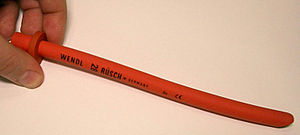Wendl tube
A Wendl tube (presented in 1958 by Johann Karl Wendl ) or a nasopharyngeal tube according to Wendl is a tube made of soft rubber or plastic that is inserted through the nose and the tip of which comes to rest in the throat . The Wendl tube is used to keep the airways clear (in emergency medicine, if there is no endotracheal intubation or ventilation via a laryngeal mask or combitubus, or in patients in the postoperative phase after anesthesia) by preventing the pharynx from being obstructed by the relapsing base of the tongue when the consciousness is clouded Patient prevented. After inserting the Wendl tube, it may be more beneficial to leave the patient's head , which may have been overstretched as a result of a previously performed life-saving manipulation, in its posture.
If protective reflexes are still present, the Wendl tube is usually better tolerated and less likely to trigger a gag stimulus than the Guedel tube . The Guedel tube has a similar function, but is inserted through the mouth.
The size of Wendl tubes is given in Charrière units ; Wendl tubes are available in the sizes Charr. 16 to Fr. 36 (in adults mostly Fr. 24 to 34, 5.5 to 8.5 mm) and in lengths of 9 to 17 cm.
further reading
- K. Roberts, H. Whalley, A. Bleetman: The nasopharyngeal airway: dispelling myths and establishing the facts. In: Emerg Med J. 22 (6), Jun 2005, pp. 394-396. Review. PMID 15911941
- JW McIntyre: Oropharyngeal and nasopharyngeal airways: I (1880-1995). In: Canadian journal of anesthesia = Journal canadien d'anesthesie. Volume 43, Number 6, June 1996, pp. 629-635, doi : 10.1007 / BF03011778 , PMID 8773872 .
- Walied Abdulla: Interdisciplinary Intensive Care Medicine. Urban & Fischer, Munich a. a. 1999, ISBN 3-437-41410-0 , p. 7: Nasopharyngeal tube (Wendl tube) .
